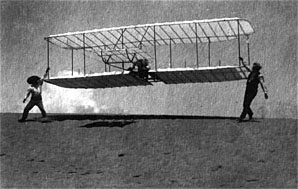By Sandra Hasenauer
On a recent road trip I whiled away the hours listening to David McCollough reading his book The Wright Brothers. I’d bought it simply because I’m a McCollough fan and I don’t know much beyond the basic legends about this famous pair. Little did I know I’d be hearing a story that connected so meaningfully with American Baptist Women’s Ministries.

The second Wright glider was flown at Kitty Hawk, N.C., in July and August 1901. (U.S. Air Force photo, public domain, http://1.usa.gov/1JyIBZs.)
The Wright brothers were not trained aviation engineers. Indeed, there really wasn’t such a thing in the early 1900s. In those years, people were simply experimenting with the idea of what it would mean to travel by air. There were studies and charts and mathematical formulas around the physics of flight, but no one had yet actually accomplished it. The Wright brothers, inspired by a childhood toy given to them by their father—a rubber-band powered helicopter—entered into their own study of birds, kites, and physics.
The part of the story that struck me most powerfully was McCollough’s recounting of the brothers on the train back from Kitty Hawk, North Carolina, to their home in Dayton, Ohio, after their second season of testing. The first few months they’d spent in Kitty Hawk with their first glider were encouraging—tests went well. But the second testing period the following year was terribly disheartening. As they rode the train back home, McCollough states that they came to the discouraging realization that all of the charts and graphs about the theory of flight by physicists were incorrect. As no one had yet actually flown, the theories at the time were (as theories are) just “best guesses” at what might happen in certain conditions. But the Wright brothers’ experiments had proven that those guesses wouldn’t work.
Upon realizing that they no longer had the ability to fall back on what was already known, they were at first ready to toss in the towel. McCollough describes that train ride in quite poignant terms–the frustration and sadness is almost palpable. But after awhile, the brothers decided they needed to forge ahead. They had a passion for flight, so they were determined to fly. To achieve their goal, the brothers had to throw out everything they thought they knew. They had to go back to their own observations of birds in flight and run several more years of experiments before they finally achieved manned, prolonged, and controllable flight. McCullough tells of the speech that Wilbur Wright gave to The Western Society of Engineers in 1901 (after the discouraged train ride described above), in which Wright described learning to fly. He suggests that one way to learn how to ride a horse is by sitting safely on a fence and watching the horse for awhile and “at leisure figure out the best way of overcoming his jumps and kicks,” while the other way to learn is to get on the horse and learn by actual practice. “It is very much the same in learning to ride a flying machine; if you are looking for perfect safety, you will do well to sit on a fence and watch the birds; but if you really wish to learn, you must mount a machine and become acquainted with its tricks by actual trial.”*
Can you see where I might be going with this?
Our women’s ministries are learning how to fly in a world that is swiftly proving that what we used to know may no longer “work.” The theories and practices of former times may no longer lead to effective ministries today, for a wide variety of reasons. The world is different now—people are different now—women are different now. We could easily, like the Wright brothers, be riding the train home in discouragement, ready to give it all up. Or we could, again like the Wright brothers, decide that the goal of what we’re trying to accomplish is far too important. We can be ready to enter into a world of experiments, becoming acquainted with new visions of ministry by actual trial.
Virginia Holmstrom’s January 11 blog post shared AB Women’s Ministries’ engagement in our initiative on living out our cultural reality into God’s intentional desire. Is there a clear road map as to how we’re going to do this? Are there charts and graphs and established practices that will guarantee success every time? Of course not. In this age of uncertainty, we have to embrace a little Wright Brother in our attitudes: What we don’t know, we can learn. But we can only learn by actual trial. Like the Wright Brothers, we have to be ready to experiment, and we have to be prepared for the long haul.
This takes time. Learning how to do ministry with women and girls today takes one key element: getting to know women and girls. It’s about relationships. It’s about sitting down over coffee or tea and sharing our stories with one another. It’s about respecting others not in spite of their differences, but because of their differences. It’s understanding how those differences make us stronger, able to weather the sometimes unpredictable currents we’re living in. Building relationships takes time. Discerning God’s call to us as individuals, to our women’s and girls’ ministries groups, and to AB Women’s Ministries as an organization takes time.
The Wright brothers had to spend time getting to know the nature of air, gravity, and aerodynamics before they found success. It took them years—there was no fast fix or step-by-step guidebook. What can God teach us about ministry through this story of two brothers who were passionately committed to an idea? If we’re passionately committed to the idea of ministry with women and girls, are we ready to put in the time? Are we ready to try the untried, to set out on paths that may not have been flown before? “See, I am doing a new thing! Now it springs up; do you not perceive it?” (Isaiah 43:19, NIV)
*Quotations from “Some Aeronautical Experiments,” Mr. Wilbur Right, Dayton, Ohio, presented to the Western Society of Engineers, September 18, 1901, http://invention.psychology.msstate.edu/inventors/i/Wrights/library/Aeronautical.html. Also see McCullough, David, The Wright Brothers (New York: Simon & Schuster, 2015).
 Rev. Sandra Hasenauer serves as the associate executive director of American Baptist Women’s Ministries.
Rev. Sandra Hasenauer serves as the associate executive director of American Baptist Women’s Ministries.

Wow, Sandra, thanks for sharing the wisdom from the Writght Brothers’ book and bringing it into our ABWM world. Yes, we do need to get on to ways our women can really fly in their lives and connecting with each other.